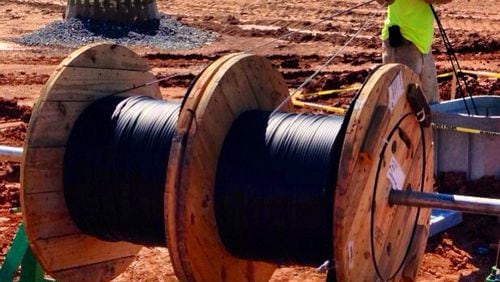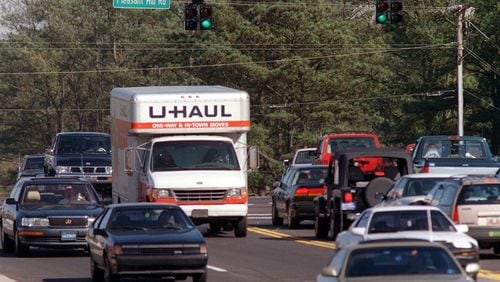When bells ring at the end of the day in schools across rural Georgia, the local fast-food joints know what to expect.
Gobs of students descend on the McDonald’s, Burger Kings and Wendy’s in small towns across the state.
But it’s not a Big Mac, Whopper or Frosty many of the kids are after. It’s Wi-Fi.
Sixteen percent of Georgians do not have high-speed internet access, and the vast majority of those broadband deserts are in rural counties. While all public schools in Georgia have broadband internet, many students don’t. And in an age when web access is required for homework and other assignments, students go where they can to get online.
And that's a problem, Tifton Mayor Julie Smith told a panel of state leaders researching the needs of rural Georgia.
Broadband access is a “challenge,” she said.
“The availability of that is so important, especially for schoolchildren,” Smith told the House Rural Development Council at a recent meeting in her South Georgia town. “If they cannot get their homework done when they’re home … they can’t learn. If they can’t learn, they can’t go to secondary education. If they can’t get to secondary education, we don’t have a trained workforce.”
It’s not just students. Small businesses, the backbone of most rural communities, increasingly rely on the internet for ordering, sales, payroll and more.
In tiny Bluffton, in southwest Georgia, Jean Turn is the comptroller for White Oak Pastures, a world-renowned farm famous for its grass-fed beef and pastured poultry.
The farm is easily the town’s largest employer and has a burgeoning online market. But doing business online is not always easy, Turn said.
“Broadband is always an important thing,” she said. “We have 10 megs! We’re top-of-the-line, top-of-the-list!”
In Albany, John Hansen is one of the lucky ones. His internet provider, Mediacom, recently launched 1-gigabit (1,000 megabits) service in 52 rural communities, including Albany. Hansen is an IT professional, and the new higher speeds available to him allow him to respond to client emergencies from home.
“I can hook up to my computer at work (from home), I can remote into whatever server is down, without slowing down, without seeing a difference in performance,” Hansen said.
He also has a 19-year-old daughter at home who is in college. She can do research and take online classes without bogging down Hansen’s system, he said.
There’s a human experience element to the problem, too. The internet provides the world at one’s fingertips, an endless opportunity of art, knowledge, language, culture and diversity.
A recent study by the University of Georgia’s Carl Vinson Institute asked rural Georgians to share information about internet access at their home or business.
Out of more than 11,000 responses, only 29 percent said their internet speeds were sufficient, while 79 percent said access to broadband was very important to their quality of life. More than 60 percent said it was very important to their ability to earn a living.
It is not a problem unique to Georgia. A recent Pew Research Center study found 73 percent of Americans have broadband access at home. For rural Americans, however, that number drops to 63 percent. “Broadband” can mean many things, although the Federal Communications Commission defines it as internet access with speeds of 25 megabits per second.
The numbers are moving in the right direction, though. Ten years ago, only 35 percent of rural Americans had high-speed internet at home compared with just more than half of all Americans.
In Georgia, too, access is improving. Georgia ranks 19th overall in broadband access and 14th for rural access, according to a state House of Representatives study.
Telecommunications companies are investing heavily to bring big-city speeds to rural areas. Beyond Mediacom, Stephen Loftin, the executive director of the Georgia Cable Association, told lawmakers last month that the cable industry alone has invested $3 billion over the past decade and now serves 1.6 million people.
Cox Communications has offered discounted internet service to low-income families since 1999. Cox’s Connect2Compete program offers low-cost internet to k-12 families enrolled in the free or reduced lunch program in schools in 18 states, including Georgia. It was expanded last year to include any U.S. Housing and Urban Development-assisted family with children in communities it covers, which includes a number of small towns in Middle Georgia.
Cox Communications and The Atlanta Journal-Constitution are both units of Sandy Springs-based Cox Enterprises.
The challenges are immense. High-speed internet typically requires new wires to be hung on power poles with lines running from the poles to an individual home or business. That’s expensive, and more so in rural communities where local electric co-ops or municipal electric utilities charge companies three times what Georgia Power charges to use their poles.
Right-of-way access “has always been guaranteed for telephone companies,” AT&T lobbyist Kevin Curtin said. “But when you start deploying broadband, and not voice service, the laws have not kept up with technology. Last time they were edited, the statute still said telegraph service.”
It can cost up to $5,000 per mile per year in fees in Georgia to hang broadband wires, while 35 states have eliminated right-of-way access fees.
Then, there are taxes. While 23 states have eliminated sales taxes on broadband deployment, Georgia isn’t among them. Sales taxes on telecommunications equipment generates about $33 million a year here.
“That makes a big difference,” Loftin said. “If South Carolina and North Carolina don’t tax network equipment but Georgia does, that’s another 5, 6, 7 percent depending on the county that gets added to the cost of that service.”
And while Georgia ranks fairly high in terms of access to broadband, it does worse when it comes to signing up for it. AT&T’s Curtin said while the state is 19th overall in broadband access, it ranks 28th in the number of people getting the service. Curtin said AT&T invested $5.5 billion on wired and wireless networks in Georgia from 2013 to 2015.
Loftin said it’s hard to get a return on investment if a company has to string wire past 10 homes to get to one customer.
“If you had an 80 percent adoption rate, you could serve a much broader area,” he said.
The future, then, is likely not to be in wires running from poles to homes and businesses, industry experts agreed. It’s in wireless technology. Curtin said AT&T will begin an experiment this year for its Project AirGig, which envisions superfast internet hubs atop power poles that beam gigabit speeds into nearby homes.
“If this technology pans out the way we hope,” he said, “it will be a huge opportunity and game change for rural Georgia.”
GOVERNMENT AND POLITICAL NEWS
If it happens in Washington or under the Gold Dome, The Atlanta Journal-Constitution has somebody there to tell you what it means for all Georgians. Follow our coverage at http://www.myAJC.com/politics.
You can also join the conversation on Twitter at http://Twitter.com/GAPoliticsNews or Facebook at http://facebook.com/gapoliticsnewsnow/.







